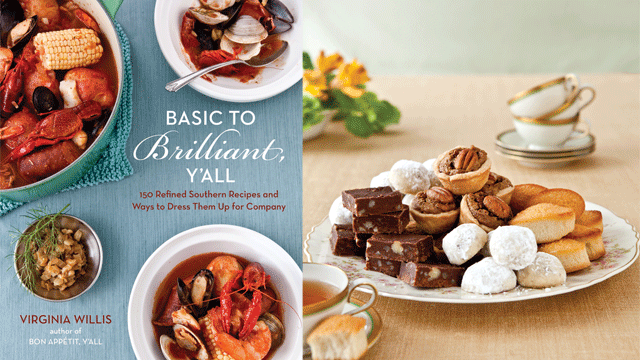
(Helene Dujardin 2011)
“I generally like my bourbon in a glass.” That’s how chef and author Virginia Willis begins her Bourbon Soaked Pecan recipe. Remove the pecans after thirty minutes, she says, and save the bourbon for another use, i.e., “see first sentence.”
Every region has its holiday traditions: New England’s oyster stew and rich chowders, smoked and fresh salmon in the Pacific Northwest, Southwestern tamales, Texas’ tamales and cornbread dressing, Hawaii’s Kalua Turkey, slow-roasted and shredded, Midwestern Stollen, a sweet, yeasty bread filled with nuts and candied fruit and dusted with confectioner’s sugar and the fruit- or nut-filled Danish Kringle pastry.
Abundance is hallmark of the South -- courtesy of the region’s agricultural richness and the resourcefulness of its cooks.
Most Southerners usually serve turkey and ham for Christmas. “We have a heavy influence of food in our culture to begin with,” says Willis, a Georgia-born and bred, classically French-trained chef.
The southern holiday tableaux of cakes, pies, fruitcakes and cookies “in greater profusion than at Thanksgiving” is a natural extension “of the Southern sweet tooth, says Willis. A panoply of desserts is simply tradition.
The Willis’ Christmas of the past began right after Thanksgiving when they’d put up their tree and, “Mama would start making candy.” Mama ramped up with peanut brittle and divinity, white nougat made with corn syrup, sugar, egg whites, vanilla and nuts. Mama also made weekly pound cakes to keep up with company.
Ambrosia more than anything else means Christmas says Willis. Usually it’s canned mandarin oranges and other fruits mixed with marshmallows, maraschino cherries, whipped topping and shredded coconut. Willis’ has coconut, oranges, a little sugar, maybe. Nothing else. Ever.
“My grandfather did most of the work,” she says describing how he peeled and sliced navel oranges leaving no pith, seeds or membrane. Holding a coconut in one hand and a hammer in the other, he cracked it, drained it, peels it, and wiped each piece creating a pile of pristine white shards. Then he’d shred the coconut on the small side of the grater—“I can still hear the rhythmic scrubbing,” she says—as he filled a three-gallon container with shredded and sliced fruit.
He didn’t care about “being a sissy in the kitchen. Wasn’t a problem for him,” laughs Willis of her six-foot, four-inch grandfather, a “big man with huge hands.” While he hammered, grated and sliced, her grandmother would cook Christmas dinner for 30. It was just her grandparents. “They were not restaurant people,” she says. They cooked the way people used to cook during the holidays.
Willis combines her years of cooking and working in France and New York with what she learned in her grandmother and mother’s Georgia kitchens in Basic To Brilliant, Y’all: 150 Refined Southern Recipes and Ways to Dress Them Up for Company (Ten Speed Press).
“Our love for sweets has a historical and geographical basis,” says Willis. Sugarcane cultivation in the Caribbean and the Deep South gradually supplanted fruit and honey as the preferred sweetener of choice.
Southern ports like New Orleans, Charleston and Savannah were the gateway for sugar coming in from the Caribbean. A developing road system gradually spread sugar throughout south. “It was a precious thing trotted out only for special occasions and one reason we started having so many desserts,” she says.
Pecan Tassies, bite-sized pecan pies, are another Willis family tradition. Holidays “were family- and church-driven,” says Willis, and grandmother didn’t keep liquor in the house. But deep in the recesses of one cupboard lived a bottle of whisky, “brought out to make fruitcakes only,” the memory of which inspired this recipe.
For basic Tassies, press a cream cheese pastry crust into muffin tin wells and then fill with a sugar, butter, egg, vanilla and pecan mixture. For “brilliant” ones, bathe the pecans in Bourbon. The smokiness of bourbon marries with the sweetness of pecans, elevating them “into something my grandmother wouldn’t have thought of,” laughs Willis.
Cookies are a large part of dessert too, especially Wedding Cookies aka “Mexican Wedding Cakes,” “Butterballs,” “Russian Tea Cakes,” “Swedish Tea Cakes,” and, least appealingly, “Moldy Mice.”
They’re those powdery white cookies, usually round, sometimes crescent-shaped, that melt silkily in your mouth. Basically it’s a shortbread made with finely chopped nuts. Press them into tartlet shells, bake-off, then fill with pastry cream or with whipped cream and fruit.
Think of Willis’ basic recipes as a little black dress and her brilliant add-ons as that perfect string pearls. Your holiday table will never look, or taste, better.
